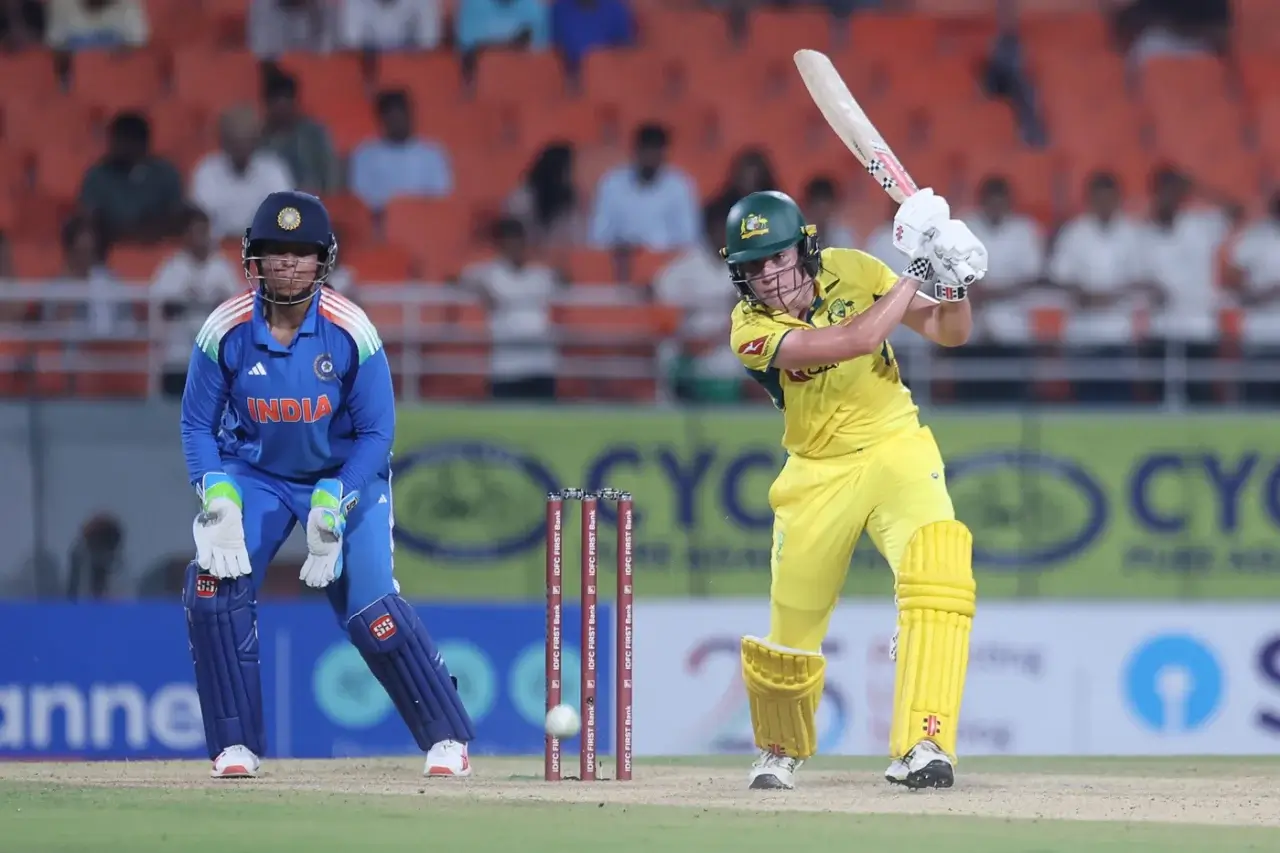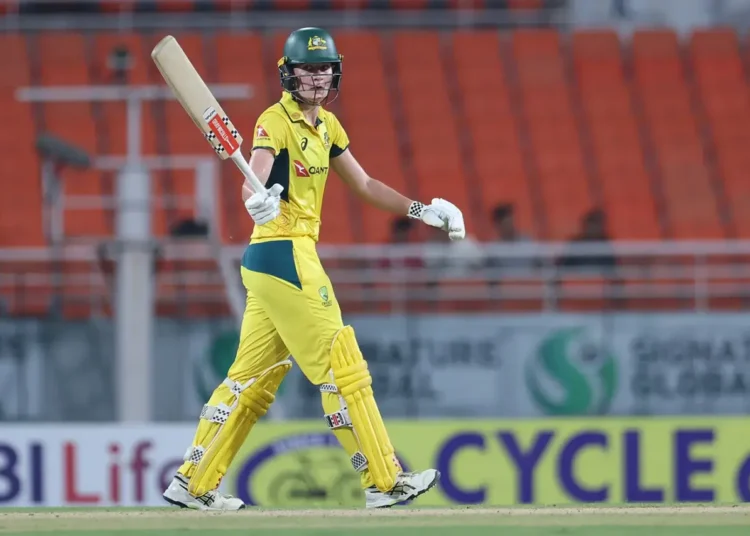At the 2025 Women’s ODI World Cup, one name has towered above the rest: Annabel Sutherland. At just 23, she has transformed into Australia’s most complete match-winner — dismantling batters at the death, rebuilding innings in crisis, and carrying herself with the calmness of a veteran.
With 15 wickets at 13.33, the most death-overs wickets (9), and a match-winning 98 not out against England, Sutherland is proving that she is not just an all-rounder but Australia’s X-factor. Her rise has been a blend of skill, adaptability, and mental toughness — and her performances in the World Cup are defining this tournament, like australian mindset.
The Evolution of Annabel Sutherland – From Rising Star to World Cup Hero

Sutherland’s journey began in Australia’s domestic setup, where she stood out for her raw pace and power hitting. Through the WNCL and WBBL, she honed her game, learning to swing the new ball and clear boundaries in the middle order.
Her early international years were promising but inconsistent. Often in the shadow of stars like Ellyse Perry and Ashleigh Gardner, she worked tirelessly on fitness, variations, and batting discipline. Fast forward to 2025, and those investments have paid off. She’s no longer a supporting act — she’s the headline performer of the World Cup.
The Headline Stat: Queen of the Death Overs
No bowler has been deadlier in the final 10 overs this World Cup than Sutherland. She has nine wickets at the death, nearly double the next best bowler. In an era where batters often dominate the slog, Sutherland flips the script.
Her weapon of choice is the back-of-the-hand slower ball. Seamless in action and impossible to pick, it forces batters to commit too early. Even proven finishers like Sophie Devine have fallen victim, beaten for lack of pace.
What makes her more dangerous is that her slower ball is paired with real pace. One over she’s bouncing batters out, the next she’s deceiving them into mistimed shots. That unpredictability is why Australia’s death overs have turned into a winning phase.
The Variation Package: One Action, Two Speeds, No Cues
Most bowlers give away their variations with visible changes in action. Sutherland doesn’t. Her bouncer, cutter, and slower ball all look identical out of the hand, giving batters no time to adjust.
Against India in Visakhapatnam, just as Jemimah Rodrigues was preparing to launch, Sutherland slipped in her disguised slower ball. Rodrigues lost shape and holed out, triggering India’s collapse to just 43 runs in the last seven overs.
This ability to disguise pace without sacrificing rhythm makes Sutherland one of the hardest bowlers to line up in world cricket, like dominating the timeline.
Middle-Order Rock: The 98* That Flipped England
If her bowling made headlines, her batting against England cemented her as an all-rounder of the highest order.
Australia were 68/4, chasing 245 in Indore. The English seamers were moving the ball, and spinners were choking the middle overs. The match looked gone.
But Sutherland stayed calm, built an innings ball by ball, and alongside *Ashleigh Gardner (104)**, produced a record-breaking 180-run unbeaten partnership — the second-highest fifth-wicket stand in women’s ODI history.
Her 98 not out from 89 balls was a masterclass in crisis management and acceleration. By the time she walked off, Australia had romped home with 10 overs to spare. That knock was not just about runs — it was about announcing herself as a middle-order rock who thrives under pressure.
Crisis Champion: Reading Conditions, Not Just Scoreboards
What makes Sutherland stand apart is her game awareness. She doesn’t just react to the score — she reads the pitch, conditions, and opposition to adjust her tactics.
With the ball, she varies lengths depending on grip and bounce. With the bat, she knows when survival is key and when acceleration is possible. Against India, she bowled three different phases perfectly. Against England, she switched gears at the right moment to take the game away.
Her philosophy is simple but effective: enjoy pressure, don’t fear it. That mindset has made her Australia’s go-to player in clutch situations.
Built for India… and for Finals
Unlike many overseas players who struggle in India, Sutherland has thrived. Her years with the Delhi Capitals in the WPL gave her experience against quality spin and on slow surfaces. She learned alongside legends like Ellyse Perry and Marizanne Kapp, adding new dimensions to her game.
Those experiences are now paying off. Whether it’s bowling on slow turners or batting against world-class spinners, Sutherland looks at home. Heading into the semi-final in Navi Mumbai, her comfort with Indian conditions makes her a major threat.
Semi-Final Stakes: India vs Australia, Navi Mumbai
Australia enter the semi-final with 15 straight World Cup wins, and Sutherland is at the heart of this streak. For India, beating Australia means finding a way to neutralize her.
The tactical blueprint is clear:
-
Attack her early overs before she settles.
-
Avoid reaching the death overs with wickets in hand where her slower balls dominate.
-
Exploit Australia’s weakness to left-arm spin while bowling.
But as it stands, India’s biggest challenge is not just beating Australia — it’s preventing Sutherland from deciding the game’s key moments.
Why Annabel Sutherland Is Australia’s Ultimate All-Round Asset?

Every team wants an all-rounder, but very few get one who excels with both bat and ball at the highest level. Sutherland is that rare commodity.
-
With the ball, she’s a death-overs assassin who closes innings ruthlessly.
-
With the bat, she’s a finisher and stabilizer, able to play both anchor and aggressor.
-
In the field, her athleticism adds yet another weapon to Australia’s arsenal.
She gives Australia balance, depth, and flexibility — the three ingredients that win tournaments.
The Psychology Behind Sutherland’s Success
Skill alone doesn’t explain Sutherland’s rise. What separates her is her mental game. She embraces the pressure of big moments, calling herself a “competitor” who enjoys the challenge.
She invests heavily in preparation: tactical planning, long pre-seasons, and mental conditioning. That preparation shows on the field — she rarely looks rattled, even in crisis.
This mental edge has turned her from a promising all-rounder into a World Cup match-winner.
What Annabel Sutherland Means for the Future of Women’s Cricket?
Sutherland is more than just Australia’s present. She represents the future of women’s cricket: versatile, fearless, and tournament-ready.
Her success shows how franchise leagues like the WPL sharpen skills and create global stars. Her journey also provides a blueprint for young cricketers worldwide — combining adaptability, fitness, and mental strength.
As the women’s game grows, Sutherland stands as the prototype of the modern all-rounder who can dominate all phases of play.
Conclusion: Australia’s X-Factor at the World Cup
Annabel Sutherland’s 2025 Women’s World Cup has been nothing short of phenomenal.
-
She’s the death-overs menace, leading the tournament in wickets at the back end.
-
She’s the middle-order rock, rescuing Australia with one of the innings of the tournament.
-
She’s the crisis-proof competitor, adapting seamlessly to every challenge.
-
She’s the India-tested pro, bringing WPL experience into high-pressure World Cup games.
For Australia, she is the player who tilts games in their favor. For opponents, she is the ultimate puzzle — how do you stop someone who can win matches with both bat and ball?
As the semi-finals approach, one truth is clear: in Annabel Sutherland, Australia have found their World Cup X-factor, a player capable of doing it all.





